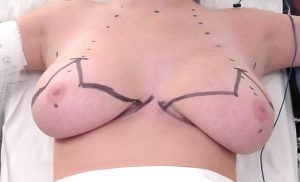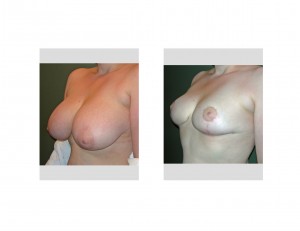One of the most common plastic surgery procedures done for teenage girls is breast reduction. Most women, young or older, have this surgery because they have large breasts that restrict their activities and give them pain. While older women usually have large breasts that have considerable sag (ptosis), teenage girls will not have as much sag due to never having yet been pregnant in most cases.
Teens with very large breasts will have numerous symptoms including back, neck and shoulder discomfort from by the excessive weight. The bra straps will often leave groves or indentations in the shoulders. But of equal importance is that most teens will feel extremely self-conscious. So much so that they alter their wardrobe to hide the size of their breasts and will often not participate in any sporting activities.
One form of a developmental breast deformity that should not be confused with just that of simple juvenile breast hypertrophy is gigantomastia. This is an extreme form of breast overgrowth where the size of the breasts are remarkable and massive. It is unique to the teen years and is an exaggerated response to higher levels of estrogen after puberty. If it appears in only one breast with significant differences in size, one should think of a tumor specifically a large fibroadenoma. This needs further evaluation with an MRI before surgery.
A key question is the timing of breast reduction in teens. In most cases, breast reduction is not considered until at least age 18 when the breasts more are fully developed. However, it can be considered earlier depending upon the size of the breasts and how much physical discomfort they are causing. Because of the changes that will occur to the breasts from pregnancy, ‘pre-childbirth’ breast reduction should be considered carefully so that its benefits are too short-lived. It has been recommended that breast reduction should not be done in those women who intend to breast-feed, but the operation does not preclude the ability to breast feed after as the nipple is not removed during the operation.

Permanent scars in the form of an ‘anchor’ pattern is the long-term price to be paid for a breast reduction, but the comfort and pain relief with smaller breasts are worth that trade-off for most teens. But the creation of scars is the reason why breast reduction should not be done for cosmetic reasons only. While plastic surgeons are experts at making scars as thin as possible, they are nonetheless extensive and permanent. They will feel firm and appear red in color for months, eventually fading to thin white lines.
Swelling and bruising are typical for the first few weeks after surgery, but it takes months before the breasts settle into their final shape. Being a teen, breast shape will still be affected by future events such as hormone changes, weight gain and loss and most certainly pregnancy.

Dr. Barry Eppley
Indianapolis, Indiana


